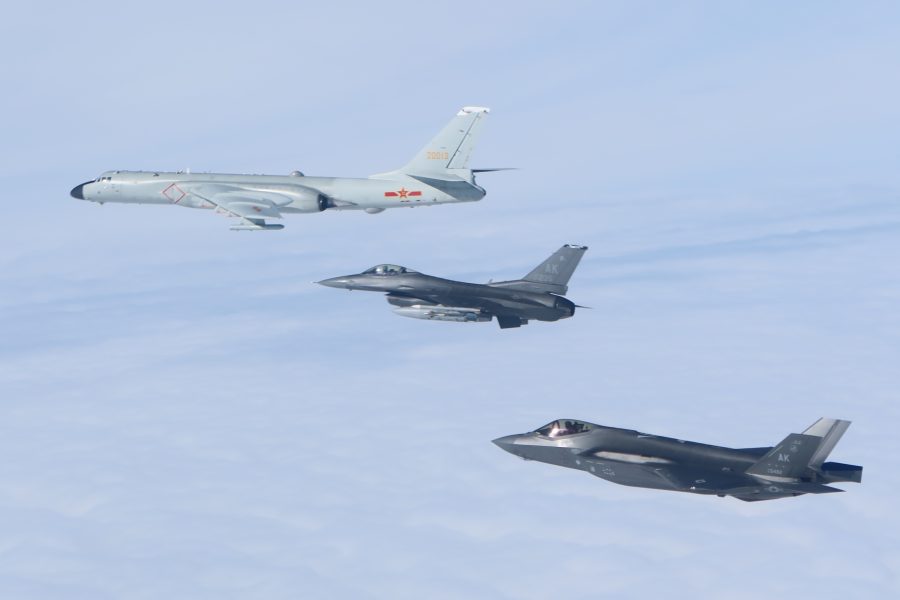China is set to increase its military activity around Alaska, likely including bomber flights, the top U.S. general in charge of defending North America said Feb. 13.
“I do think that [China will] increase their presence both independently and as well as increased cooperation with the Russians in the air, in the maritime, and undersea,” Air Force Gen. Gregory M. Guillot, the commander of U.S. Northern Command (NORTHCOM) and North American Aerospace Defense Command (NORAD), told the Senate Armed Services Committee.
Chinese and Russian military flights have become a growing concern for the U.S. over the past year, most notably with the first joint Chinese-Russian bomber patrol into the Alaska Air Defense Identification Zone (ADIZ) last July. In that episode, two Chinese H-6 bombers and two Russian TU-95 bombers flew off the coast of Alaska inside the U.S. ADIZ, escorted by Russian fighters. American and Canadian NORAD fighters intercepted the mission.
That flight was a demonstration of China and Russia’s growing partnership, while China has also provided dual-use technology to fuel Russia’s war in Ukraine. Last July, the Chinese and Russian bombers took off from the same base in Russia for their mission near Alaska, Air & Space Forces Magazine reported at the time.
Guillot indicated the growing collaboration between the two countries was one of his main concerns going forward.
“Their transfer of weapons, military technology, and basing access is cause for significant concern,” Guillot said in his opening statement to the committee.
“What I worry about the most is that instead of just weapons and technology, that they will trade [basing] access, which would shorten our timelines to react to either country’s military capabilities,” he added later.
Guillot also said that in addition to military flights, he was concerned about Chinese naval activity near Alaska, which he said was increasing. Multiple Chinese and Russian flotillas were tracked by the U.S. last year, and a high-profile exercise in 2023 involving nearly a dozen Chinese and Russian ships prompted U.S. Navy destroyers to shadow the fleet.
Until February 2024, Guillot was the deputy commander of U.S. Central Command (CENTCOM), which oversees U.S. forces in the Middle East, where the U.S. has defended against Iran and its extensive network of proxy groups, had run-ins with Russian aircraft over Syria, and been concerned about China’s growing influence in the region. That experience appeared to inform his testimony to the committee.
“The growing cooperation between China, Russia, North Korea, and Iran to challenge the United States” has “direct implications for homeland defense,” Guillot said.
In addition to Guillot’s concerns over Chinese activity, the general said Moscow was also upping its unilateral bomber flights near Alaska and Canada to levels not seen in years.
“The associated risks to North America have also grown as the number of Russian bomber incursions into Alaska and Canadian Air Defense Identification Zone has returned to levels not seen since before the Russian invasion of Ukraine” in February 2022, Gulliot said. He said a similar trend has played out with naval activity. “We’ve seen a significant increase in both Russian air and maritime activity in the vicinity of Alaska, both in the Bering Sea and up in the Arctic Ocean.”
Russia has also upped its flights off the east coast to North America, he said. Russian military flights in the Arctic last month prompted NORAD to conduct fighter patrols off Alaska and Canada, and NORAD recently sent U.S. F-16s on a deployment to Greenland.
“We’ve also seen an increase in air patrols on the eastern side, what we call the two o’clock approach through the Greenland and Iceland Gap towards Maine and the northeast portion of the United States,” Guillot said. “I’m certainly concerned by that. And I would expect the numbers on both sides of our coast to increase in the coming year.”


